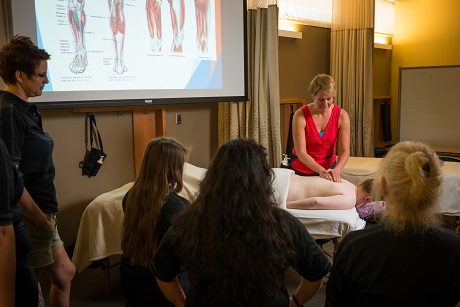The learning journey of massage
Combining science and ancient traditions, licensed massage therapy training at COCC creates careers with impact
In a softly lit classroom in the Health Careers Center at Central Oregon Community
College (COCC), with conifers outside framed by high, transom-style windows, students
of the massage therapy program sit at portable massage tables (doubling as desks)
and contemplate a wildly colorful chart that lights up the lecture screen.
The image represents chakras—or, bodily energy zones. At the center sits a meditative figure, partly obscured by a column of seven, vertically oriented circles. Tie-dye colors bloom riotously from the center.
“What does that make you think of?” asked Alan Nunes, program director of massage therapy, of his class of 21 students. “Woodstock!” ventured a male student to laughter. “It’s emotional cartography,” explained Nunes with a smile, encapsulating his lesson for the day on chakras, part of the “Eastern Theory & Practice” class that explores Chinese medicine and Eastern philosophy.
Students of the licensed massage therapy (LMT) program at COCC certainly learn massage mechanics while pursuing their certificate or degree, but they also come away with an education layered in culture and history. Coursework ranges from Zen Shiatsu and Thai massage to neuromuscular, sports and Swedish massage to kinesiology. It’s a science-based program of diverse teachings and in-depth practices.
It’s also the only LMT program in Oregon that offers an Associate of Applied Science degree option. Accredited by the Commission on Massage Therapy Accreditation, the college’s program also offers a faster-track certificate of completion that requires four, full-time terms of schooling, with credits structured so that students can more quickly license and put their career into gear.
Students of the licensed massage therapy (LMT) program at COCC certainly learn massage mechanics while pursuing their certificate or degree, but they also come away with an education layered in culture and history.
And those careers are looking differently than they did just a few short years ago. While massage therapy used to occupy the very periphery of the health care field—deemed an alternative, if indulgent practice—massage today is widely integrated into wellness plans and treatment practices, and highly embraced within the athletic population.
“In the early 90s, there came an understanding of its value through the evolution of sports training,” Nunes explained after his class. “The scientific benefits of massage began to be seen far beyond relaxation.”
Recent graduate Chandra Hess combines both massage therapy and personal training in her work. “I was drawn to massage therapy because I was looking for a way to expand my knowledge as a personal trainer,” explained Hess, who splits her time between the Sisters Athletic Club and Bodywork of Bend. “I loved studying kinesiology and I love helping people live healthier and happier lives. Massage and personal training compliment each other really well.”
Health studies have documented the many benefits of massage therapy. Massage can lessen pain, lower blood pressure and promote deeper, healthier sleep. It can be used to help alleviate fatigue with cancer patients. One study at Cedars-Sinai found that participants of a Swedish massage group underwent a noticeable boost to their immune system, with the bodywork actually elevating lymphocytes, white blood cells that help thwart disease. Massage, in this case, as a manufacturer of antibodies.
As more states have required licensing for massage therapists (as is the case with Oregon, mandated by the Oregon Board of Massage Therapists), general acceptance—and demand—has grown. According to the American Massage Therapy Association, a 2016-17 survey indicated that some 50 million adults in the U.S. had spoken with their health care provider or physician about massage therapy; fifty-nine percent of those medical professionals either referred or encouraged massage practices.
The industry rates as a top-ranking growth field, as gauged by the U.S. Bureau of Labor Statistics, which projects a 26 percent expansion in the industry between 2016 and 2026 (by contrast, the average for all occupations hovers at seven percent). In Oregon, according to the same agency, the massage therapy sector ranked third in the nation last year for highest annual mean wage at $59,390; both the Eugene and Medford markets skewed higher.
“I knew I wanted to do something in the medical profession,” said Margo Bruguier, who just completed the program and now works as a massage therapist at a chiropractic clinic in Eugene. “Something that promoted wellness, using the most natural processes possible.” For Bruguier, the program helped with her own personal journey of healing, which she now pays forward. “I love when my clients come off the table, standing taller, and are able to act more vibrant than before because they’ve taken care of themselves in mind, body and spirit.”
At COCC, students can enter the program each year in the fall (a day program) or in the spring (an evening program). Nunes said that key outcomes of the program include personal growth and learning how to be a health educator. “They discover a profound connection with others and with self,” he said of his students. “This work is centered in giving, connection, ancient tradition and science—it’s a profound journey.”
By Mark Russell Johnson, COCC College Relations

